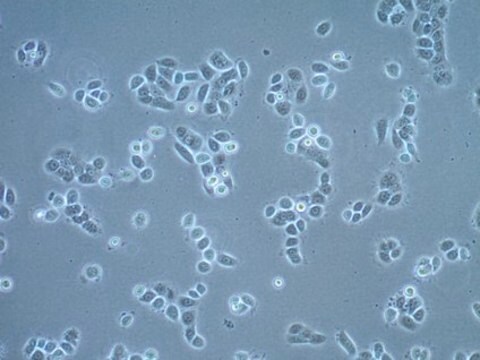SCC148
MB49 Mouse Bladder Carcinoma Cell Line
Mouse
Synonim(y):
MB-49
Zaloguj sięWyświetlanie cen organizacyjnych i kontraktowych
About This Item
Kod UNSPSC:
41106514
eCl@ss:
32011203
NACRES:
NA.81
Polecane produkty
product name
MB49 Mouse Bladder Carcinoma Cell Line, MB49 mouse urothelial carcinoma cell line is widely used as an in vitro and in vivo model of bladder cancer.
pochodzenie biologiczne
mouse
Poziom jakości
metody
cell culture | mammalian: suitable
Warunki transportu
ambient
Powiązane kategorie
Opis ogólny
MB49 cells are derived from C57BL/Icrf-a’ mouse bladder epithelial cells that were transformed by a single 24-hour treatment with the chemical carcinogen 7, 12-dimethylbenz[a]anthracene (DMBA) on the second day of a long term primary culture . Transformed cells transplanted into syngeneic mice were shown to generate carcinomas . While of male origin, karyotype analyses indicate the loss of the Y chromosome in 100% of the cells analyzed . This abnormality is a frequent early event in human bladder cancer. A recent study indicates that MB49 cells recapitulate key features of sex differences in bladder tumor growth . MB49 implantation in mice resulted in significantly larger tumors in males than females. In the presence of dihydrotestosterone, MB49 cells exhibited enhanced proliferation in a dose-dependent manner. In contrast, MB49 cells were unresponsive to the pregnancy hormone, human chorionic gonadotrophin (hCG) . MB49 cells exhibit low to no expression of MHC-Class I and II molecules . However, upon exposure to IFN-, the expressions of MHC Class I and II are significantly upregulated .
Jakość
• Each vial contains ≥ 1X106 viable cells.
• Cells are tested negative for infectious diseases by a Mouse Essential CLEAR panel by Charles River Animal Diagnostic Services.
• Cells are verified to be of mouse origin and negative for inter-species contamination from rat, chinese hamster, Golden Syrian hamster, human and non-human primate (NHP) as assessed by a Contamination CLEAR panel by Charles River Animal Diagnostic Services.
• Cells are negative for mycoplasma contamination
• Cells are tested negative for infectious diseases by a Mouse Essential CLEAR panel by Charles River Animal Diagnostic Services.
• Cells are verified to be of mouse origin and negative for inter-species contamination from rat, chinese hamster, Golden Syrian hamster, human and non-human primate (NHP) as assessed by a Contamination CLEAR panel by Charles River Animal Diagnostic Services.
• Cells are negative for mycoplasma contamination
Inne uwagi
This product is intended for sale and sold solely to academic institutions for internal academic research use per the terms of the "Academic Use Agreement" as detailed in the product documentation. For information regarding any other use, please contact licensing@emdmillipore.com.
Kod klasy składowania
10 - Combustible liquids
Klasa zagrożenia wodnego (WGK)
WGK 2
Temperatura zapłonu (°F)
Not applicable
Temperatura zapłonu (°C)
Not applicable
Certyfikaty analizy (CoA)
Poszukaj Certyfikaty analizy (CoA), wpisując numer partii/serii produktów. Numery serii i partii można znaleźć na etykiecie produktu po słowach „seria” lub „partia”.
Masz już ten produkt?
Dokumenty związane z niedawno zakupionymi produktami zostały zamieszczone w Bibliotece dokumentów.
Zheng Zhu et al.
Clinical cancer research : an official journal of the American Association for Cancer Research, 28(21), 4820-4831 (2022-08-04)
Immune checkpoint inhibitors (ICI) in general have shown poor efficacy in bladder cancer. The purpose of this project was to determine whether photodynamic therapy (PDT) with bladder cancer-specific porphyrin-based PLZ4-nanoparticles (PNP) potentiated ICI. SV40 T/Ras double-transgenic mice bearing spontaneous bladder
E C Lattime et al.
Cancer research, 52(15), 4286-4290 (1992-08-01)
Intravesical administration of Bacillus Calmette-Guérin (BCG) is the most effective therapy for superficial transitional cell carcinoma of the bladder although its mechanism of action is not known. To determine if bladder tumors are capable of antigen presentation and thus might
I C Summerhayes et al.
Journal of the National Cancer Institute, 62(4), 1017-1023 (1979-04-01)
Neoplastic transformation of C57BL/lcrf-a' mouse bladder epithelium was induced in long-term primary cultures by a single 24-hour treatment with 7,12-dimethylbenz[a]anthracene on day 2 of culture. Transformed foci appeared earlier (40--60 days) and at a higher frequency (28%) in cultures from
Victoria T Fabris et al.
Cancer genetics, 205(4), 168-176 (2012-05-09)
Bladder cancer is frequently associated with chromosomal abnormalities, and the complexity of karyotypes increases with tumor progression. The murine model MB49 is one of the most widely studied models of bladder cancer. We developed the invasive cell line MB49-I by
Adnan Deronic et al.
Cancer immunology, immunotherapy : CII, 70(12), 3629-3642 (2021-05-06)
Non-responders to checkpoint inhibitors generally have low tumor T cell infiltration and could benefit from immunotherapy that activates dendritic cells, with priming of tumor-reactive T cells as a result. Such therapies may be augmented by providing tumor antigen in the
Nasz zespół naukowców ma doświadczenie we wszystkich obszarach badań, w tym w naukach przyrodniczych, materiałoznawstwie, syntezie chemicznej, chromatografii, analityce i wielu innych dziedzinach.
Skontaktuj się z zespołem ds. pomocy technicznej








